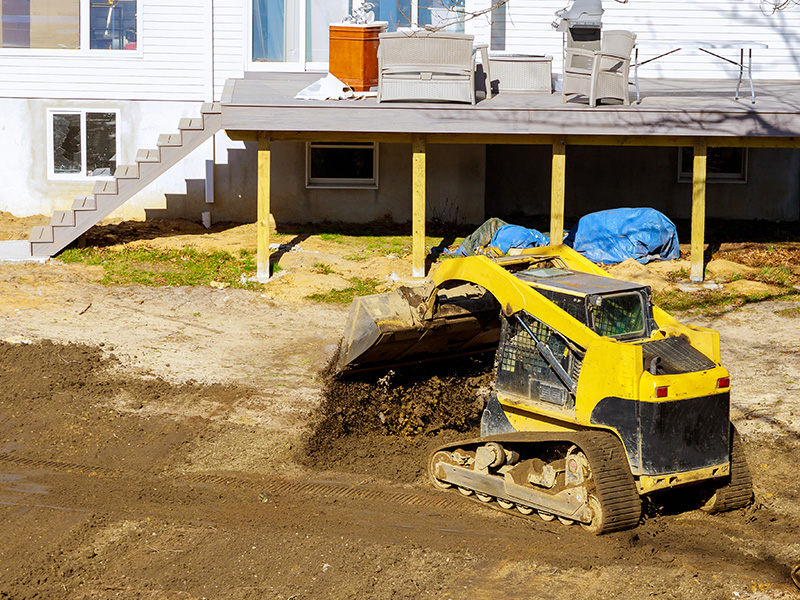The Importance of Grading and Leveling
If you own property in the Lowcountry, you know the joys and challenges that come with living near the water. What you might not know is the importance of grading and leveling in making certain your property stays comfortable, pleasant, and liveable.
While stunning views and access to the ocean are perks, without proper drainage, your property can turn into an unpleasant ‘mudscape.’
What is Grading?

Grading involves sculpting the earth around your home to create specific slopes. The goal is to direct water flow away from your foundation, preventing issues like basement flooding, erosion, and structural damage.
Proper grading ensures excess rainwater from storms or irrigation is safely channeled into storm drains, swales, or designated retention areas.
What is Leveling?
While grading focuses on slopes, leveling is concerned with creating flat, even surfaces. This is pivotal before laying foundations, paving driveways or patios, or even installing a beautiful lawn.
A level surface provides stability and prevents issues like sinking, cracking, or uneven settling.
When You Need Grading and Leveling Work
The goal of good grading and leveling is, among other things, to manage the risks of damage due to poor water drainage.
When you’re designing and building a home, your professional contractor should work with you to make sure your property drains properly. However, landscapes change, and problems with water drainage can still occur years after construction is done.
If the water that accumulates on your property from general rain or runoff does not drain into appropriate areas, it can lead to more complicated and expensive problems. Here’s what to look for:
- Standing Water: Persistent puddles that act not only as barriers to walking but also attract mosquitoes and other nasty critters.
- Soggy Patches: Damp or muddy areas that linger long after raining.
- Erosion: Channels or gullies that form from consistent water flow can disrupt your lawn’s beauty and function.
- Unhealthy Plants: Uncontrolled water flow can result in water saturation, leading to plants dying from ‘overwatering.’
Why It’s Even More Critical for Coastal Homes
For coastal homes, proper water drainage can be even more critical to your home’s foundation and landscape. Many homes along coastal areas – or areas surrounded by swampy land – have foundations that might exist at or below sea level.
- Storm Surge and Flooding: If you’re building a new home, grading plans should place the building site above the base flood elevation. It’s also crucial to direct excess water away from the home’s foundation using slopes, retention ponds, french drains, dry wells, and other drainage systems.
- Saltwater Intrusion: If you’re close to the shoreline, seawater can infiltrate the soil, damaging building foundations and affecting vegetation. To protect against this, you can use swales (shallow, vegetated channels) to redirect seawater or install salt-tolerant vegetation to create a landscape buffer.
- Local Regulations: Keep in mind that coastal zones might have strict regulations governing grading, leveling, construction practices, and shoreline protection. Regulations might restrict building size, set minimum elevations for structures, and even control the types of materials used in landscaping.
- Sand and Wind: If you’re near the ocean, sand movement and wind erosion can also affect proper water drainage. Grading plans might implement measures like retaining walls, strategic plantings, or buffers to stabilize the soil and protect landscapes.
Diagnosing Drainage Problems – What to Look For
If left alone, water drainage issues can become long-lasting and expensive problems. Keep a watchful eye for these signs:
- Pooling Water: The most obvious indicator of trouble. Be mindful of when water collects around your foundation, in specific low spots, or in areas where it should disperse.
- Basement or Crawlspace Issues: Foundation cracks, dampness, mold, or even musty smells in your basement or crawlspace signify water intrusion.
- Erosion: Observe your landscape after storms – are there noticeable areas where soil is washing away?
- Plant Health: Stunted plants, yellowing leaves, or areas of dying vegetation, especially in unexpected places, can signal either oversaturation or insufficient water.
- Neighbor Comparison: Sometimes a side-by-side look at neighboring properties can be revealing. Does your property hold water longer than adjacent lots after storms?
Remember that early detection is key. Even small signs can escalate into major problems if left unaddressed. If you’re unsure, you can always contact a professional to diagnose your property and whatever issue that is causing concern. It’s better to be safe than sorry, as the saying goes.
Contact Icon Construction:
Call us at 843-814-0094 or email us at sam@lowcountryicon.com